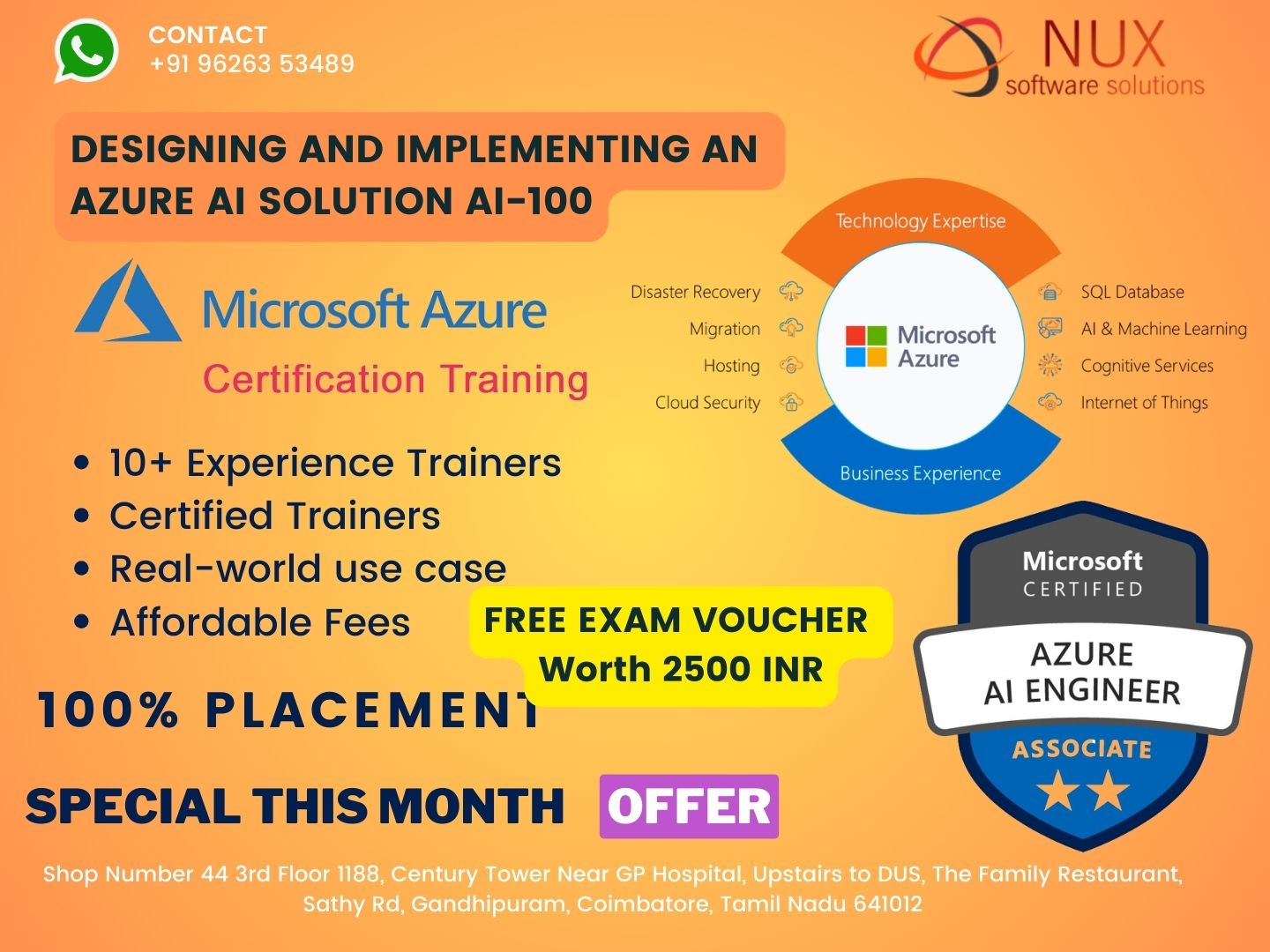Microsoft Certified: Designing and Implementing an Azure AI Solution AI-100 Training and Certification

AI-100: Azure AI Solution Design Training in Coimbatore
Course Overview
The AI-100 certification course, Designing and Implementing an Azure AI Solution, is designed for professionals aiming to architect and build AI solutions using Microsoft Azure’s cognitive and machine learning services. This course provides a strong foundation in integrating computer vision, natural language processing (NLP), knowledge mining, and conversational AI into modern applications.
At Linux Training Center in Coimbatore, our expert-led sessions combine theory and hands-on labs to help learners design scalable, secure, and responsible AI solutions using Azure tools and APIs.
Why Choose AI-100?
As businesses increasingly leverage AI to enhance operations and customer experiences, skilled professionals who can design and manage intelligent applications are in high demand. The AI-100 course helps bridge the gap between development and design of AI solutions—focusing on architecture, governance, and integration.
This training is a pathway to earn the Microsoft Certified: Azure AI Engineer Associate credential, demonstrating your expertise in implementing AI workloads using Azure.
Who Should Enroll?
The course is ideal for AI engineers, solution architects, software developers, and cloud engineers involved in planning and deploying AI-based solutions. It’s also beneficial for professionals transitioning into AI from related fields like application development or cloud infrastructure.
Familiarity with Azure services, APIs, and basic data science concepts is recommended.
What You Will Learn
Identify the right Azure AI services for various business requirements
Design and implement computer vision and language understanding solutions
Build and manage conversational bots using Azure Bot Services and QnA Maker
Plan AI workflows with responsible AI practices and data privacy compliance
Configure deployment environments, security, and monitoring for AI solutions
Integrate AI capabilities into applications using SDKs and REST APIs
Learners will gain practical experience through projects that simulate real-world AI solution design scenarios.
Course Highlights
Covers Microsoft AI-100 certification exam topics in detail
Instructor-led live sessions with use-case-based demonstrations
Real-time labs using Azure Cognitive Services and Azure ML
Learn to build and deploy AI solutions end-to-end
Convenient weekday and weekend batch options
Career Opportunities
Completing this course opens doors to roles such as Azure AI Engineer, Cognitive Services Developer, AI Consultant, or Machine Learning Solution Architect. The AI-100 certification enhances your profile in industries focusing on smart automation, digital transformation, and intelligent customer engagement.
Why Linux Training Center?
Linux Training Center in Coimbatore provides specialized training in AI, cloud, and automation technologies. With industry-certified trainers and hands-on labs, we ensure each learner gains the confidence and skills to implement impactful AI solutions using Microsoft Azure.
Microsoft Certified: Designing and Implementing an Azure AI Solution AI-100 and AI-102 Syllabus
Modules
Analyze solution requirements (25-30%)
Recommend Azure Cognitive Services APIs to meet business requirements
- select the processing architecture for a solution
- select the appropriate data processing technologies
- select the appropriate AI models and services
- identify components and technologies required to connect service endpoints
- identify automation requirements/li>
Map security requirements to tools, technologies, and processes
- identify processes and regulations needed to conform with data privacy, protection, and regulatory requirements
- identify which users and groups have access to information and interfaces
- identify appropriate tools for a solution
- identify auditing requirements
Select the software, services, and storage required to support a solution
- identify appropriate services and tools for a solution
- identify integration points with other Microsoft services
- identify storage required to store logging, bot state data, and Azure Cognitive Services output
Design AI solutions (40-45%)
Design solutions that include one or more pipelines
- define an AI application workflow process
- design a strategy for ingesting and egress data
- design the integration point between multiple workflows and pipelines
- design pipelines that use AI apps
- design pipelines that call Azure Machine Learning models
- select an AI solution that meets cost constraints
Design solutions that uses Cognitive Service
- design solutions that use vision, speech, language, knowledge, search, and anomaly detection APIs
Design solutions that implement the Microsoft Bot Framework
- integrate bots and AI solutions
- design bot services that use Language Understanding (LUIS)
- design bots that integrate with channels
- integrate bots with Azure app services and Azure Application Insights
Design the compute infrastructure to support a solution
- identify whether to create a GPU, FPGA, or CPU-based solution
- identify whether to use a cloud-based, on-premises, or hybrid compute infrastructure
- select a compute solution that meets cost constraints
Design for data governance, compliance, integrity, and security
- define how users and applications will authenticate to AI services
- design a content moderation strategy for data usage within an AI solution
- ensure that data adheres to compliance requirements defined by your organization
- ensure appropriate governance of data
- design strategies to ensure that the solution meets data privacy regulations and industry standards
Implement and monitor AI solutions (25-30%)
Implement an AI workflow
- develop AI pipelines
- manage the flow of data through the solution components
- implement data logging processes
- define and construct interfaces for custom AI services
- create solution endpoints
- develop streaming solutions
Integrate AI services and solution components
- configure prerequisite components and input datasets to allow the consumption of Azure Cognitive Services APIs
- configure integration with Azure Cognitive Services
- configure prerequisite components to allow connectivity to the Microsoft Bot Framework
- implement Azure Cognitive Search in a solution
Monitor and evaluate the AI environment
- identify the differences between KPIs, reported metrics, and root causes of the differences
- manage the flow of data through the solution components
- maintain an AI solution for continuous improvement
- monitor AI components for availability
- recommend changes to an AI solution based on performance data
Microsoft AI-102 Exam Syllabus
- Select the appropriate service for a vision solution
- Select the appropriate service for a language analysis solution
- Select the appropriate service for a decision support solution
- Select the appropriate service for a speech solution
- Select the appropriate Applied AI services
- Manage account keys
- Manage authentication for a resource
- Secure services by using Azure Virtual Ne
tworks
- Plan for a solution that meets responsible AI principles
- Create an Azure AI resource
- Configure diagnostic logging
- Manage costs for Azure AI services
- Monitor an Azure AI resource
- Determine a default endpoint for a service
- Create a resource by using the Azure portal
- Integrate Azure AI services into a continuous integration/continuous deployment (CI/CD) pipeline
- Plan a container deployment
- Implement prebuilt containers in a connected environment
- Create a solution that uses Anomaly Detector, part of Cognitive Services
- Create a solution that uses Azure Content Moderator, part of Cognitive Services
- Create a solution that uses Personalizer, part of Cognitive Services
- Create a solution that uses Azure Metrics Advisor, part of Azure Applied AI Services
- Create a solution that uses Azure Immersive Reader, part of Azure Applied AI Services
Implement image and video processing solutions (15-20%)
- Select appropriate visual features to meet image processing requirements
- Create an image processing request to include appropriate image analysis features
- Interpret image processing responses
- Extract text from images or PDFs by using the Computer Vision service
- Convert handwritten text by using the Computer Vision service
- Extract information using prebuilt models in Azure Form Recognizer
- Build and optimize a custom model for Azure Form Recognizer
- Choose between image classification and object detection models
- Specify model configuration options, including category, version, and compact
- Label images
- Train custom image models, including classifiers and detectors
- Manage training iterations
- Evaluate model metrics
- Publish a trained iteration of a model
- Export a model to run on a specific target
- Implement a Custom Vision model as a Docker container
- Interpret model responses
- Process a video by using Azure Video Indexer
- Extract insights from a video or live stream by using Azure Video Indexer
- Implement content moderation by using Azure Video Indexer
- Integrate a custom language model into Azure Video Indexer
Implement Natural Language Processing Solutions (25-30%)
- Retrieve and process key phrases
- Retrieve and process entities
- Retrieve and process sentiment
- Detect the language used in text
- Detect personally identifiable information (PII)
- Implement and customize text-to-speech
- Implement and customize speech-to-text
- Improve text-to-speech by using SSML and Custom Neural Voice
- Improve speech-to-text by using phrase lists and Custom Speech
- Implement intent recognition
- Implement keyword recognition
- Translate text and documents by using the Translator service
- Implement custom translation, including training, improving, and publishing a custom model
- Translate speech-to-speech by using the Speech service
- Translate speech-to-text by using the Speech service
- Translate to multiple languages simultaneously
- Create intents and add utterances
- Create entities
- Train evaluate, deploy, and test a language understanding model
- Optimize a Language Understanding (LUIS) model
- Integrate multiple language service models by using Orchestrator
- Import and export language understanding models
- Create a question answering project
- Add question-and-answer pairs manually
- Import sources
- Train and test a knowledge base
- Publish a knowledge base
- Create a multi-turn conversation
- Add alternate phrasing
- Add chit-chat to a knowledge base
- Export a knowledge base
- Create a multi-language question answering solution
- Create a multi-domain question answering solution
- Use metadata for question-and-answer pairs
Implement Knowledge Mining Solutions (5-10%)
- Provision a Cognitive Search resource
- Create data sources
- Define an index
- Create and run an indexer
- Query an index, including syntax, sorting, filtering, and wildcards
- Manage knowledge store projections, including file, object, and table projections
Implement Conversational AI Solutions (15-20%)
- Design conversational logic for a bot
- Choose appropriate activity handlers, dialogs or topics, triggers, and state handling for a bot
- Create a bot from a template
- Create a bot from scratch
- Implement activity handlers, dialogs or topics, and triggers
- Implement channel-specific logic
- Implement Adaptive Cards
- Implement multi-language support in a bot
- Implement multi-step conversations
- Manage state for a bot
- Integrate Cognitive Services into a bot, including question answering, language understanding, and Speech service
- Test a bot using the Bot Framework Emulator or the Power Virtual Agents web app
- Test a bot in a channel-specific environment
- Troubleshoot a conversational bot
- Deploy bot logic



